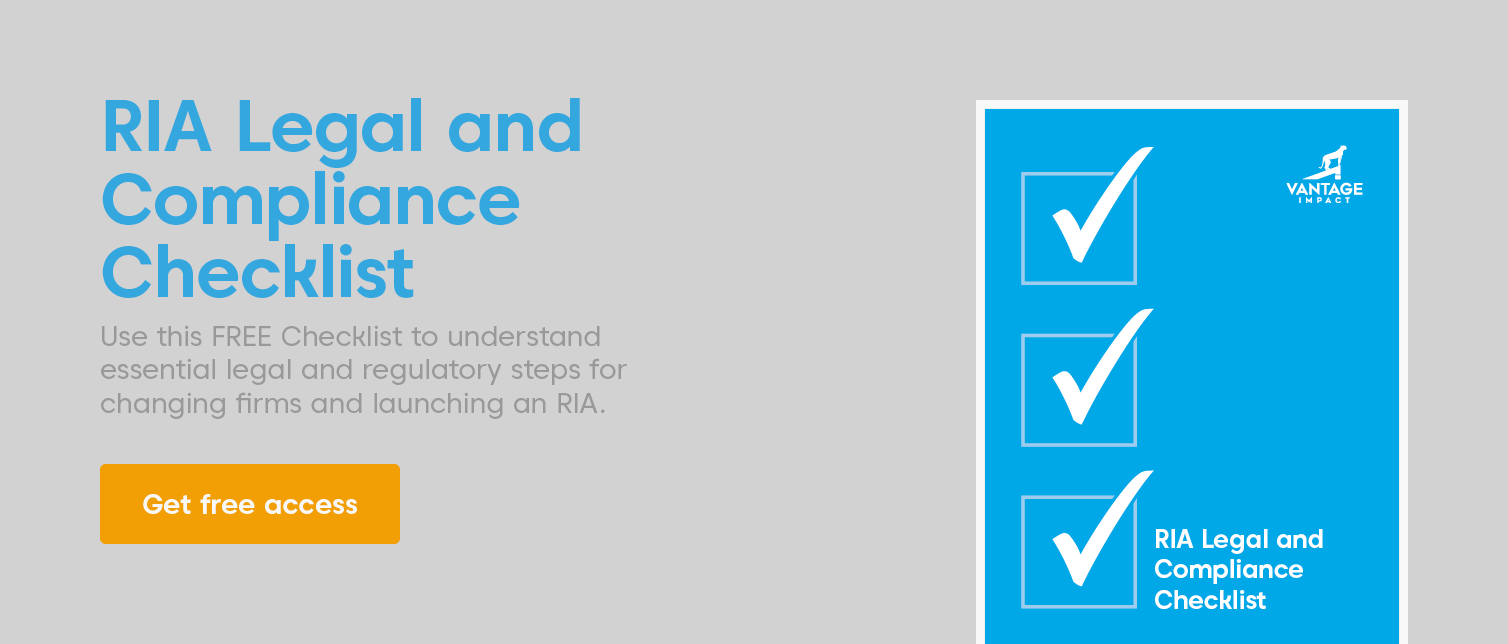The process of changing firms and launching your own RIA can be challenging for advisors to navigate. There are a number of legal and regulatory matters to consider, especially early on in the process. So where do you even begin?
We’ve come up with a list of some of the most important items to think about as you tackle this process—which we admit can be complicated if you’re not prepared. This list is intended to be a starting point and will vary based on your individual circumstances. Some of these items will take coordination with your old firm, attorney and other third parties, and some actions may take a while to complete, so we encourage you to get started as early in your transition journey as possible.
Want a quick overview of our checklist? Click here to download. Read on for a more in-depth look at this process, and then download the checklist at the end, so you can refer back to it.
After reading, you should have a better idea of what it will take to ensure you have everything in line from a legal and compliance standpoint, ensuring that this exciting transition goes as smoothly as possible. However, it’s critical that you consult an attorney on the proper path forward given your individual circumstances as the contents of this blog do not constitute legal advice.
Preparing for Your Transition From Another Firm
Chances are, if you’re at a firm today, and you’re planning to branch out on your own as an independent RIA, you aren’t going to make that decision overnight. If you do your homework, a lot of analysis is going to happen before you decide “yay: an independent RIA is for me,” or “nay: staying with a larger broker-dealer is a better fit for me.” Or you might end up tucking into an existing RIA as a way to outsource certain aspects of the process. Part of this analysis should include what the transition will look like.
What does a transition analysis entail? Think about the obligations you have, and the rules of the agreements and policies currently in place with your existing firm, which you likely agreed to years ago when you first joined your current firm. It’s a good idea to review all relevant materials, which may include employment agreements, company policies, and promissory notes with your current firm, as well as non-compete, non-solicitation and confidentiality agreements. The contents of these documents and the laws and regulations that govern your activities at your existing and new firm will define what you can and cannot do during the transition process.
Analyzing contracts, policies and agreements may not be your forte, which is why it’s always a good idea to get legal advice as you’re going through a transition process. An experienced attorney should be able to help you identify the agreements and other documents you should take into consideration and the obligations you must fulfill before making your transition. As Richard Chen of the law firm of Richard L. Chen PLLC explains, “Carefully developing a plan and following it to the tee when making a transition can be the difference between a smooth transition and one that ends with legal action from the advisor’s previous employer.”
Forming Your New RIA
You’ve done the research, conducted your analysis, stayed up way too many nights weighing the pros and cons, and you’ve finally reached your decision—you’re going to take the leap and form a new RIA. Independence, here you come!
Time to get started…on lots of paperwork. Much like starting any small business, when you form an RIA, you need to take the proper steps, and file with all the proper authorities, to be legitimately recognized and authorized to conduct business. Be sure to consider all of the following steps, as applicable:
- Formation filings (to form the RIA entity)
- Foreign state qualification (if doing business in a state other than the state where you formed your RIA)
- Trademark registration filings (to protect your business name or brand)
- Employer identification number (EIN) registration
- Plan for optimal tax structuring for the owners keeping in mind any estate planning considerations
- Drafting the operating agreement for your RIA to define the rights and obligations of owners (including economic rights, management/voting rights, and buy/sell provisions)
With these items taken care of, it’s time to turn to the legal and regulatory considerations for operating the RIA business.
Registering Your Firm and Its Personnel
You’ve taken the initial steps to form your entity and define the rules of the road for the owners. Now it’s time to ensure your firm is properly registered and authorized to give investment advice, as well as ensuring the firm’s advisory employees are properly registered.
The first thing you’ll need to do is to conduct an analysis of where you must register as an investment adviser (either with the SEC or one or more states) or if you are exempt from registration as an investment adviser. To register with the SEC and/or one or more states, you’ll need to file Form ADV to register the firm. The information that must be completed on Form ADV will vary depending on whether you are registering with the SEC or one or more states. Next, you’ll need to consider whether any of your advisory employees are required to register as an investment adviser representative with any states. If you need to register any such advisory employees, you’ll need to have such person(s) file Form U4 and comply with other requirements of the states with which they are registering. You may also need to prepare brochure supplements that will provide important information about your advisory employees to your clients.
Building Your Compliance Program
So you’ve just completed a lot of paperwork to make sure you and your personnel are properly licensed and registered to operate your business. Now, for regulatory and other reasons, you should, and could be required to, adopt policies and procedures designed to ensure that the firm runs smoothly and mitigates business and legal risks.
Among other things, you should strongly consider adopting data security policies and privacy policies designed to protect client data. You should also adopt a business continuity plan designed to address how the firm would pivot in the event of a significant business disruption including, among other things, the death or disability of the principals. You may also need to adopt various policies and procedures to handle conflicts of interest that arise in the course of running the business. The policies and procedures that are needed will depend on whether the firm is registered with the SEC or one or more states as well as the nature of the business and the clients being served.
It will take some work—gathering all of the pieces to put these policies in place—but they will provide a roadmap and help you run your business more efficiently and effectively. Prospective clients will also be more likely to trust your firm with their financial information and decisions if you have a robust compliance program in place.
Considering Other Essential Legal Matters
While the above tips will provide a solid foundation for your firm, it’s important not to neglect other important legal matters that can significantly impact your firm.
Among other things, it’s critical to draft appropriate client agreements that clearly explain your arrangement with clients while protecting the firm’s interests. It’s also vital to carefully review commercial contracts with vendors to ensure that they adequately protect the firm’s interests.
If the firm will be hiring employees and independent contractors, it’s critical to have properly-drafted agreements that clearly define the relationship and protect the firm. Employment policies and procedures will also be required, and those will vary depending on the state(s) where the firm conducts business.
If the firm is launching any private funds, it will be important to understand the regulations governing private funds and to ensure that any fund offering documents are properly drafted.
Next Steps
You may be at an exciting turning point in your career. The advantages of launching your own RIA are an exciting prospect that could benefit you, your employees and clients in a myriad of ways. But we get it—there is a lot to think about, and it’s easy to get overwhelmed with all of the to-dos. That’s why we’re here to help. We can even help with next steps, like building your branding, website, messaging and more. Check out our marketing and communications checklist to get your ideas flowing.
We want to make the decision process easier for you, and help set you up for a smooth transition. If you have questions after reviewing this information and would like guidance, feel free to give us a call. Want a quick cheat sheet that covers what you learned today? Click here and download or print a copy.



